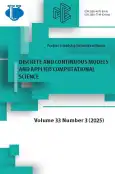Исследование иероглифов с помощью методов аудиовизуального цифрового анализа
- Авторы: Егорова М.А.1, Егоров А.А.1
-
Учреждения:
- Российский университет дружбы народов
- Выпуск: Том 33, № 3 (2025)
- Страницы: 309-326
- Раздел: Письма в редакцию
- URL: https://bakhtiniada.ru/2658-4670/article/view/348825
- DOI: https://doi.org/10.22363/2658-4670-2025-33-3-309-326
- EDN: https://elibrary.ru/HEVOIT
- ID: 348825
Цитировать
Полный текст
Аннотация
Проведённое исследование античных письменных текстов и знаков показало, что иероглифы и строение архаического предложения имеют много общего с современным китайским языком. В контексте истории и эволюции китайского языка подчёркнуты его характерные тональность и мелодичность. Основное внимание в работе уделено исследованию звуковых свойств иероглифов (ключей), встречающихся одновременно в древнейших надписях, а также в современных текстовых сообщениях. В статье использованы современные цифровые методы анализа звуков с одновременной их визуализацией. Для характеристики звучания иероглифов (в соответствии с принятой в Китае фонетической транскрипцией Пиньинь) использованы две (FI, FII), три (FI, FII, FIII) или четыре форманты (FS, FI, FII, FIII), которые создают характерную F-картину. Предложенная нами модель четырёх формант для типовых иероглифов (ключей) названа базовой «F-моделью», она является новой и оригинальной. Для визуализации формант применены программы цифровой обработки звуковых сигналов. Полученные данные сравнивались с соответствующими спектрограммами для мандаринского (стандартного) диалекта китайского языка. Установлено их соответствие друг другу. При анализе F-картин использовалась оригинальная модель, которая позволила охарактеризовать спектрограммы в частотной и временной областях. Дано формализованное описание основных компонентов базовой «F-модели» произношения иероглифов. В заключение отмечено несколько областей, в которых перспективно использование различных методов аудиовизуального исследования: передовые инновационные технологии (искусственный интеллект и виртуальная реальность); телевидение, театральное видеопроизводство; определение качества аудиовизуального контента; образовательный процесс. Проведённое исследование показало, что описанные перспективные методы исследования могут быть полезны при анализе подобных античных иероглифов.
Об авторах
М. А. Егорова
Российский университет дружбы народов
Email: Меу1@list.ru
ORCID iD: 0000-0003-2931-8330
Candidate of Political Sciences, Associate Professor at the Department of Foreign Languages of the Faculty of Humanities and Social Sciences
ул. Миклухо-Маклая, д.6, Москва, 117198, Российская ФедерацияА. А. Егоров
Российский университет дружбы народов
Автор, ответственный за переписку.
Email: alexandr_egorov@mail.ru
ORCID iD: 0000-0002-1999-3810
Doctor of Physical and Mathematical Sciences, Consulting Professor
ул. Миклухо-Маклая, д.6, Москва, 117198, Российская ФедерацияСписок литературы
- Rocchesso, D. Introduction to sound processing (Phasar Srl, Firenze, 2003).
- Bondarko, L. V., Verbitskaya, L. A. & Gordina, M. V. Fundamentals of general phonetics 4th (Academy, St. Petersburg, 2004).
- Yakhontov, S. Y. Ancient Chinese language (Nauka, Moscow, 1965).
- Vasiliev, L. S. Ancient China: in 3 volumes (Oriental Literature, Moscow, 1995; 2000; 2006).
- Atlas of the languages of the world. The origin and development of languages around the world (Lik press, Moscow, 1998).
- The peopling of East Asia: putting together archaeology, linguistics and genetics (eds Blench, R., Sagart, L. & Sanchez-Mazas, A.) (Routledge Curzon, London, 2005).
- Kryukov, M. V. & Kh., S.-I. Ancient Chinese (Vostochnaya kniga, Moscow, 2020).
- Egorova, M. A., Egorov, A. A. & Solovieva, T. V. Modeling the distribution and modification of writing in proto-Chinese language communities. ADML 54, 92-104 (2020).
- Egorova, M. A., Egorov, A. A. & Solovieva, T. M. Features of archaic writing of ancient Chinese in comparison with modern: historical context. Voprosy Istorii, 189-207 (2021).
- Zinder, L. R. General phonetics 2nd (Higher school, Moscow, 1979).
- Lee, W.-S. An articulatory and acoustical analysis of the syllable-initial sibilants and approximant in Beijing Mandarin in Proceedings of the 14th International Congress of Phonetic Sciences 413416 (San Francisco, 1999), 413-416.
- Kodzasov, S. V. & Krivnova, O. F. General phonetics (RGGU, Moscow, 2001).
- Musical encyclopedia (Soviet Encyclopedia, Moscow, 1978).
- Shironosov, V. G. Resonance in physics, chemistry and biology (Publishing House “Udmurt University”, Izhevsk, 2000).
- Chion, M. Audio-Vision. Sound on screen (Columbia University Press, NY, 1994).
- Egorova, M. A., Egorov, A. A., Orlova, T. G. & Trifonova, E. D. Methods of research of hieroglyphs on the oldest artifacts - introduction to problem: history, archeology, linguistics. Voprosy Istorii, 20-39 (2022).
- Keightley, D. N. Sources of Shang history: the oracle-bone inscriptions of Bronze Age China (Berkeley, London, 1985).
- Hieroglyph 家 “house, family” https://en.wiktionary.org/wiki/.
- Hieroglyph 立 “stand” https://en.wiktionary.org/wiki/.
- Hieroglyph 交 “exchange, transfer, give” https://en.wiktionary.org/wiki/.
- Pinson, M. H., Ingram, W. & Webster, A. Audiovisual quality components. IEEE Signal processing magazine, 60-67 (2011).
- Urazova, S. L., Gromova, E. B., Kuzmenkova, К. Е. & Mitkovskaya, Y. P. Audiovisual media in the universities of Russia: Typology and analysis of the content. RUDN Journal of Studies in Literature and Journalism 27, 808-822 (2022).
- Carlson, R. Models of speech synthesis. Proc. Natl. Acad. Sci. USA 92, 9932-9937 (1995).
- Arai, T. How physical models of the human vocal tract contribute to the field of speech communication. Acoust. Sci. & Tech. 41, 90-93 (2020).
- Story, B. H. & Bunton, K. A model of speech production based on the acoustic relativity of the vocal tract. J. Acoust. Soc. Am. 146, 2522-2528 (2019).
- Teixeira, A. J. S., Martinez, R. & Silva, L. N. Simulation of human speech production applied to the study and synthesis of European Portuguese. EURASIP Journal on Applied Signal Processing 9, 1435-1448 (2005).
- Kinahan, S. P., Liss, J. M. & Berisha, V. TorchDIVA: An extensible computational model of speech production built on an opensource machine learning library. PLOS ONE. doi: 10.1371/journal. pone.0281306 (2023).
- Maurerlehner, P., Schoder, S. & Freidhager, C. Efficient numerical simulation of the human voice. Elektrotechnik & Informationstechnik 138/3, 219-228 (2021).
Дополнительные файлы









